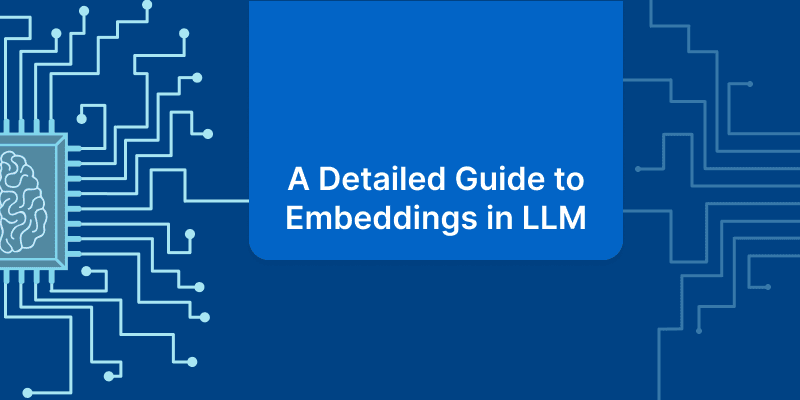A Detailed Guide to Embeddings in LLM

In the rapidly evolving world of artificial intelligence, Large Language Models (LLMs) have emerged as powerful tools for natural language understanding and generation. One of the key concepts that enable these models to process and interpret human language is embeddings. But what exactly are embeddings, and why are they so crucial to the functioning of LLMs?
What Are LLM Embeddings?
Imagine trying to teach a computer to understand words and sentences like we do. That’s what Large Language Models (LLMs) do—they help computers understand human language. But how does a computer figure out what words mean? This is where something called "embeddings" comes in.
Think of embeddings like a map. On this map, words that are similar in meaning are placed close to each other. For example, the words "cat" and "dog" would be near each other, while "cat" and "car" would be farther apart. This helps the computer know that "cat" and "dog" are more related than "cat" and "car."
In simple terms, embeddings are a way for the computer to remember and understand the relationships between words. Instead of just seeing words as random letters, the computer sees them in a way that captures their meaning and context.

How LLM use Embeddings
ow that we know what embeddings are, let’s talk about how Large Language Models (LLMs) actually use them. These are the powerful tools behind chatbots, language translators, and even AI that can write stories or answer questions.
When an LLM like ChatGPT gets a sentence, it doesn’t just see a bunch of words. Instead, it uses embeddings to understand what those words mean and how they relate to each other. This helps the AI figure out the context—basically, what the sentence is really saying.
For example, if you ask, “What’s the weather like today?”, the AI doesn’t just look at each word separately. It uses embeddings to understand that you’re asking about the weather, and that “today” refers to the current day. This way, it can give you a useful answer instead of just matching keywords.
Embeddings help LLMs go beyond just matching keywords; they allow the model to understand the deeper connections between words. This is what makes LLMs so effective at tasks like answering questions, understanding commands, or even holding a conversation.
The Role of Embeddings in Understanding Context
When we talk to someone, the meaning of our words often depends on the context—what was said before, who we’re talking to, or even the situation we’re in. The same goes for computers. To understand human language, computers need to grasp the context in which words are used, and this is where embeddings play a crucial role.
Embeddings help Large Language Models (LLMs) understand context by representing words in a way that captures their meaning and relationships with other words. For example, the word “bank” could mean a place where you store money or the side of a river. The context in which the word is used helps the LLM figure out which meaning is correct. Embeddings enable the model to make this distinction by placing words with similar meanings closer together in a mathematical space.
So, if you say, “I went to the bank to deposit money,” the LLM uses embeddings to understand that “bank” refers to a financial institution. In another sentence, “I sat on the river bank,” the model uses the surrounding words to understand that “bank” refers to the edge of a river.
By using embeddings, LLMs can maintain context throughout a conversation or a long document, allowing them to generate more accurate and meaningful responses. This ability to understand and keep track of context is what makes LLMs so powerful in tasks like answering questions, holding conversations, or translating languages.
Types of Embeddings in LLMs
Embeddings are essential for transforming various types of data into formats that Large Language Models (LLMs) can process and understand. Among the different types of embeddings, uni-modal and multi-modal embeddings are key concepts. Here’s an overview of each:
Uni-modal Embeddings
Uni-modal embeddings refer to embeddings derived from a single type of data or modality. In the context of LLMs, this typically means embeddings that represent one specific kind of data, such as text, images, or audio.
Text Embeddings:
Represent textual data using vectors that capture the meaning and context of words or sentences.
Examples:
Word2Vec: Provides word-level embeddings based on context within a text window.
BERT: Generates contextual embeddings by considering the full context of words in sentences.
Applications:
Used for tasks such as sentiment analysis, named entity recognition, and text classification.
Image Embeddings:
Represent images as vectors that capture visual features and patterns.
Examples:
ResNet: Generates embeddings by processing images through deep convolutional layers.
VGG: Uses convolutional neural networks (CNNs) to create feature vectors for images.
Applications:
Used for image classification, object detection, and image retrieval.
Audio Embeddings:
Represent audio data as vectors that capture acoustic features and patterns.
Examples:
MFCC (Mel-Frequency Cepstral Coefficients): Represents audio signals by capturing short-term power spectrum.
Wav2Vec: Creates embeddings by processing raw audio signals with deep learning models.
Applications:
Used for speech recognition, emotion detection in speech, and audio classification
Multi-modal Embeddings
Multi-modal embeddings involve the integration of multiple types of data or modalities into a unified representation. This approach enables models to leverage information from different sources simultaneously, providing a more comprehensive understanding of complex inputs.
Examples:
- CLIP (Contrastive Language-Image Pre-training): Aligns text and image embeddings to enable tasks such as zero-shot image classification and image-to-text retrieval.
- VisualBERT: Integrates visual and textual information to enhance understanding for tasks that involve both images and text.
- UNITER (Universal Image-Text Representation): Trains a model to understand both images and text by learning joint representations from these modalities.
Applications:
Used for tasks that require understanding and integrating information from multiple sources, such as image captioning, visual question answering, and cross-modal retrieval.
When working with AI, knowing about uni-modal and multi-modal embeddings can help you choose the best method for your project.
Uni-modal embeddings deal with one type of data at a time. They focus on creating detailed representations for just that single type of information. For example, text embeddings might only handle text, while image embeddings only work with images.
On the other hand, multi-modal embeddings bring together different types of data. They mix and match information from various sources, like combining text and images, to create a more complete and detailed understanding. This approach helps models handle complex tasks that involve multiple types of data.
In short, uni-modal embeddings are great for simple, single-type data tasks, while multi-modal embeddings are better for handling more complex, mixed-data situations.
Implementation of LLM Embeddings
Implementing LLM embeddings is an exciting way to unlock the potential of your text data, allowing your models to better understand and process language. If you’re using OpenAI’s models, you can generate high-quality embeddings that capture the nuances of text. Let’s walk through how you can do this step by step, with a focus on using OpenAI’s API.
Setting Up Your Environment
First, you’ll need to set up your environment to interact with OpenAI’s API. Make sure you have an API key from OpenAI and have installed the openai Python package.
pip install openaiGenerating Embeddings with OpenAI
With everything set up, generating embeddings is straightforward. OpenAI’s API makes it easy to convert your text into embeddings. Here’s a simple example:
from openai import OpenAI
client = OpenAI(api_key='your_openai_key')
text = "The quick brown fox jumps over the lazy dog."
embaddings = client.embeddings.create(input = [text], model='text-embedding-3-small').data[0].embedding
print(embaddings)In this example, we’re using OpenAI’s text-embedding-3-small model, which is one of the models optimized for generating embeddings. The model takes the input text and returns a numerical vector (the embedding) that represents the text in a high-dimensional space.
Applying Embeddings in Your Project
Once you have the embeddings, you can use them in various downstream tasks. Here are a few examples:
For instance, to compare the similarity between two pieces of text:
from openai import OpenAI
import numpy as np
client = OpenAI(api_key='your_openai_key')
text1 = "The quick brown fox jumps over the lazy dog."
text2 = "A fast brown fox leaps over a sleepy dog."
embedding1 = client.embeddings.create(input = [text1], model='text-embedding-3-small').data[0].embedding
embedding2 = client.embeddings.create(input = [text2], model='text-embedding-3-small').data[0].embedding
similarity = np.dot(embedding1, embedding2) / (np.linalg.norm(embedding1) * np.linalg.norm(embedding2))
print(f"Similarity score: {similarity}")The similarity score will tell you how close the two texts are in meaning, with 1 being identical and 0 being completely different.
Fine-Tuning (Advanced Option)
If you need embeddings that are highly tailored to your specific data or task, you can consider fine-tuning a model. However, with OpenAI’s pre-trained models, you often get high-quality embeddings right out of the box, reducing the need for extensive fine-tuning.
Scaling and Optimization
As you scale up your project, consider optimizing your use of embeddings:
- Batch Processing: Generate embeddings for multiple texts in a single API call to reduce latency.
- Dimensionality Reduction: If your application demands speed, consider techniques like PCA to reduce the dimensionality of embeddings without losing much information.
Conclusions
Embeddings are a powerful tool that transform text into numerical representations, enabling models to grasp and work with language more effectively. By understanding and using LLM embeddings, you unlock the potential to enhance various applications, from search engines to chatbots.
We’ve covered how embeddings work, the differences between uni-modal and multi-modal embeddings, and how to implement them using OpenAI’s models. Whether you’re looking to create a more intuitive user experience, improve text analysis, or simply explore the capabilities of modern AI, embeddings are key to bridging the gap between raw data and meaningful insights.
Implementing embeddings with OpenAI is straightforward and offers high-quality results. With the right approach, you can integrate these embeddings into your projects to make them smarter and more responsive to language. Remember to consider best practices for optimizing performance and addressing common challenges.
As you dive deeper into the world of embeddings, you’ll find new and exciting ways to leverage this technology. So go ahead, experiment, and see how embeddings can transform your AI applications and unlock new possibilities in language understanding!
